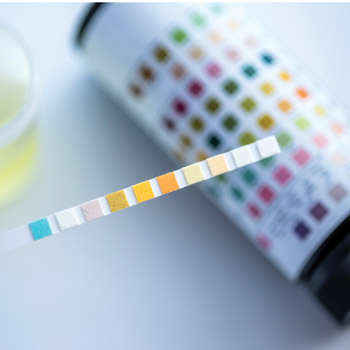Keep a close eye on the kidneys in diabetes
Screening and adherence to best prescribing practices offer two key ways to prevent or slow the progression of chronic kidney disease in patients with diabetes.
It's bad enough that millions of Americans have diabetes and chronic kidney disease (CKD). Worse still is how many of them are unaware of their condition, according to experts who spoke at the American Diabetes Association's 2020 Scientific Sessions, held virtually in June.
“In the United States, diabetes is the leading cause of new cases of end-stage kidney disease, accounting for about 47% of new cases,” said Nilka Rios Burrows, MPH, an epidemiologist in the CDC's Division of Diabetes Translation and lead of the agency's CKD Initiative. “In the U.S., and also globally, the level of CKD awareness is less than 10% in the general population of CKD patients.”

A major cause of this lack of awareness is underuse of tests for kidney damage in primary care, according to Ms. Burrows and other speakers. Naturally, that also leads to the underuse of the most effective therapies against CKD. They reviewed the evidence for these therapies and urged clinicians to take action during a session titled, “Doing Better for Diabetes and Chronic Kidney Disease.”
Increasing screening
Guidelines from the American Diabetes Association currently recommend that clinicians use urine albumin testing to screen all patients with diabetes at least annually for development or progression of CKD. Yet statistics from the U.S. Renal Data System, for example, show that this advice isn't generally followed, even in patients who have already been diagnosed with CKD.
“Less than 60% of people aged 65 or older with CKD and diabetes, or with CKD, diabetes, and hypertension, received the urine albumin test in the past year,” reported Ms. Burrows.
Underuse of this test is a problem for both patients with diabetes who are at risk of CKD and those who already have it, explained Susanne Nicholas, MD, MPH, PhD, a nephrologist with the University of California, Los Angeles. “Albuminuria can be a marker for glomerular disease, as well as cardiovascular risk. It is the first clinical indicator of diabetic kidney disease, and it's a useful tool to predict prognosis as well as to monitor response to therapy.”
The experts weren't certain why this tool is so apparently underused. “One potential reason for the suboptimal level of testing may be primary care providers are unfamiliar or uncomfortable with guidelines,” said Ms. Burrows.
More education and tools could help fix this, suggested Dr. Nicholas. “We probably need better tools to facilitate testing and assist with better risk stratification and clinical management,” she said. “If the education is increased, the awareness is increased, it could lead to early referrals to nephrologists as well as increased patient self-reporting.”
Testing is the key to CKD diagnosis because there are typically no symptoms for patients to report until the disease is advanced. “Early loss of kidney function is silent,” said Dr. Nicholas. “The patient does not become symptomatic until a significant amount of kidney function is lost.”
And while the symptoms are minor, the eventual effects are not. “Progression to end-stage kidney disease is relatively rare, occurring in about 10% of patients, but that's not because these patients are doing well; it's because the risk of mortality is so high,” said Katherine Tuttle, MD, FACP, clinical professor of nephrology at the University of Washington in Seattle and medical and scientific director for Providence Medical Research Center in Spokane.
“Nine out of 10 will die of other causes without reaching end-stage kidney disease, about half due to cardiovascular diseases,” she said. “That's very important with regard to the new therapies that target this major death risk as well as progression to end-stage kidney disease.”
Drug choices
Two older therapies, angiotensin-converting enzyme (ACE) inhibitors and angiotensin II receptor blockers (ARBs), have been the mainstays for preventing development or progression of CKD in patients with diabetes since positive results with losartan and irbesartan were published in the Sept. 20, 2001, New England Journal of Medicine.
“Ever since those studies came out nearly 20 years ago, we've been recommending treatment of hypertension and use of an ACE inhibitor or an ARB in patients who have elevated albuminuria, particularly if it's in the macroalbuminuric range,” said Dr. Tuttle.
However, once again, practice has failed to meet recommendations, she said, citing her research published by JAMA Network Open on Dec. 20, 2019. “Even those who have the hardest indication to be on an ACE or an ARB, that is, diabetes with chronic kidney disease and hypertension, we got up to a whopping 25% ACE or ARB use in the most recent period, which was 2014 to 2017,” Dr. Tuttle said.
But even getting prescriptions of these drug classes in line with guidelines wouldn't solve diabetic kidney disease, she noted. “We have a situation where these therapies, despite the fact that they did show risk reduction, were really modest in their effect on risk.”
While new therapies are needed, some already exist. “We are moving beyond ACE inhibitors and ARBs to much more effective therapies that address not only kidney disease progression but also the risk of death,” said Dr. Tuttle.
First on that list are the sodium-glucose cotransporter-2 (SGLT-2) inhibitors. The available evidence on their benefit is a silver lining to the rosiglitazone debacle of 2006, in which the drug was linked to increased risk of heart attack and stroke after it was already on the market.
“The regulatory agencies responded by requiring safety data” from diabetes drug classes that subsequently came up for approval, Dr. Tuttle explained. “What we learned was not only were they safe, but they also have reduced risks” of cardiovascular and renal events, she said.
The CREDENCE trial, published by the New England Journal of Medicine on June 13, 2019, found that patients with type 2 diabetes and CKD who were randomized to the SGLT-2 inhibitor canagliflozin had significantly lower rates of kidney failure, cardiovascular death, myocardial infarction, and stroke.
“This trial was stopped early for overwhelming efficacy, and at least for a nephrology trial, this was a first. We've had trials stopped before for futility or safety, but we've never had a trial stopped for overwhelming efficacy,” said Dr. Tuttle.
Because the efficacy data came out of safety research, experts aren't entirely sure how the drugs provide these benefits. “They certainly work by hemodynamic mechanisms, but probably others that will be important to sort out as well,” she said.
There are other barriers to widespread use of the SGLT-2 inhibitors for kidney disease, noted Ms. Burrows. “This class of drugs is currently very underused by nephrologists for a variety of reasons, including costs and the perception of it being a glucose-lowering agent only,” she said.
Another relatively new glucose-lowering drug class, glucagon-like peptide-1 (GLP-1) receptor agonists, has shown similar benefits on kidney function. “These too really have been a gift to all the fields of diabetes, cardiovascular disease, and nephrology,” said Dr. Tuttle. A meta-analysis of GLP-1 receptor agonist trials, published by The Lancet Diabetes & Endocrinology on Aug. 14, 2019, found reductions in cardiovascular events, mortality, and a composite of kidney outcomes.
Again, the mechanism of action on the kidney is uncertain. “The working hypotheses are that these work through a reduction in inflammation and also that they have a diuretic effect, to some extent, and produce a natriuresis that may be beneficial,” Dr. Tuttle said.
It may sound backward to use the drugs and then figure out how they work, she acknowledged. “The truth is that our search for new drugs for diabetic kidney disease has been less intentional than ideal. It has been somewhat random. I think the humbling thing is the two newest classes of agents that provide kidney protection are really coming from spaces we weren't looking at very closely.”
Nephrology researchers have been looking closely at many potential therapies, Dr. Tuttle noted, showing a slide with dozens of drugs that either are currently or were recently investigated for diabetic kidney disease. These ranged from protein kinase C inhibitors to gout treatments to antioxidants.
“This is not even a complete listing,” Dr. Tuttle said. “Many are still under study. Many have had terminations for safety and some for business decisions. … These failures are not entirely clinical or scientific, and many of them have been driven by investment decisions. Hopefully kidney disease is becoming a more attractive area for pharma because we certainly need more therapies.”
New therapies may eventually allow a more individualized approach to the prevention and treatment of diabetic kidney disease, she predicted. “There's a limit to how many drugs we can pile on,” Dr. Tuttle said. “I think the future is more precision phenotyping to select patients not only for therapeutic efficacy, but also for safety. It will include clinical criteria and approaches like machine learning, but also traditional and new biomarkers and tissue-based diagnostics to get to the goal of curing CKD.”
But clinicians don't have to wait for all these high-tech advances to start working toward this goal. Ms. Burrows noted that a piece of good news in CKD epidemiology is that kidney failure from diabetes among American Indians and Alaska Natives dropped 54% between 1996 and 2013, and at the virtual conference, she presented a poster showing continued decline since that time.
The Indian Health Service accomplished this success by using population health and team-based approaches, as well as by adding kidney disease prevention and education and CKD testing and case management to routine diabetes care, she said. “This decline in end-stage kidney disease is especially remarkable given the well-documented health and socioeconomic disparities in the American Indian and Alaska Native populations. … This approach might be a useful model for diabetes and CKD management in other health care systems,” Ms. Burrows said.
Disclosures: Dr. Nicholas has served as a consultant for Boehringer Ingelheim and is on an advisory board and speakers' bureau for Janssen. Dr. Tuttle has served as a consultant for Eli Lilly and Company, Boehringer Ingelheim, Astra Zeneca, Gilead, Goldfinch Bio, Novo Nordisk, Bayer, and Janssen.





